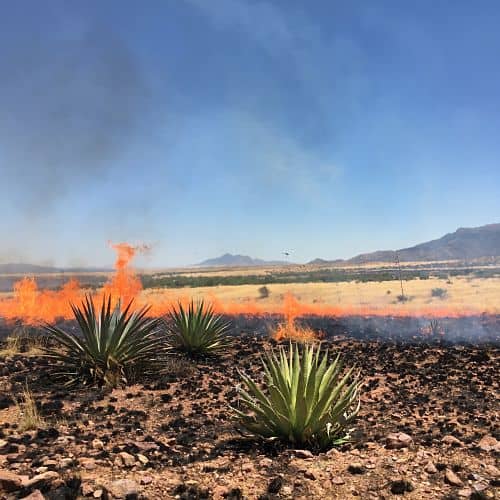Introduction
I fought 32 wildfires over fifteen months as part of my ethnographic research. I fought them with men who are currently in prison. Many western U.S. states use prison labor to fight wildfires. My dissertation examines this atypical prison program, focusing on the experiences with and meanings of such risky, skilled work from the perspective of program participants. In order to get at these meanings of wildfire work for incarcerated people, I had to jump in and dig trenches and handle flamethrowers from time to time. Fighting fires is intense, and so overwhelming from a research perspective, that I had to come up with a specific approach to remembering them.
In general, fieldwork is a multi-sensed thing. Ethnographies inevitably include what anthropologists saw, heard, smelled, tasted, and felt throughout fieldwork.
During my time in the field, I fought many fires that were small, miles away from the big flames, or that were nearly contained. These fires were fun and smoky and tiring, but manageable in the ethnographic sense. I could whip out my recorder and take notes, ask questions, reflect. But on the occasions that I went on the line[1] with the crew to do an initial attack, meaning there was a giant wall of flames that we were sent in to extinguish, I did not write anything down. I barely thought of anything but breathing and watching for shifts in the wind. Even just 10 minutes after I got off the fireline, when I tried to scribble down what I saw, I often forgot certain details because I had seen so much that it overwhelmed me.

So, over the course of fieldwork, I came up with a system to make at least some sense of my thoughts in those swirling, manically penned fieldnotes right after fighting a fire. First, I would write a descriptive summary of the fire event. Then, I broke down what I remembered by my senses: Sight, Sound, Smell, Taste, and Touch. Finally, I added a “Body” category, which described what I felt, not with my fingers and toes, but with my gut. Fear. Thrill. Exhaustion. Things that emanated from within and through me. These were the hardest to explain, but the most important in moving my writing forward.
Below is an example of one of these sets of fieldnotes. I first wrote it the night of the fire, after we had settled into a local fire department to sleep before going back on the line the next day. I expanded the summary a bit when I got home a few days later, fleshing out sentences to be full and flowing. But, for the most part, here is a day in the inferno laid bare.
Fieldnotes, 9 p.m., Wednesday, May 25
I was just on the Ransom Fire[2], which ballooned from 80 to 2,000 acres right in front of our eyes, running up and down the hills straight towards the center of a military base and its residents. It was a fire that some compared to disastrous ones, where firefighters lost their lives, because of how quickly it went from textbook containment to out-of-control. Upon arrival to the fire, when it was small but moving fast, we got out in front of the blaze, which was started on one of the base’s gun ranges with a .50 caliber bullet. We saw it moving towards us fast, and we worked even faster with drip torches and water to burn backwards towards it, so that when the fire got to us, it would have nothing left in its reach to burn.
We wrapped around it, burning the fuel on the ground and running multiple miles to put out spot fires. After about 6 hours, just when we thought we had boxed out the fire[3] and its movement, a tiny ember from a torching mesquite tree jumped the line[4] we had created, because the winds had kicked up to 45 mph at the hottest and driest part of the day. It happened right at the witching hour.
Wildland firefighters describe this time of day as when the demons come out to play.

The ember lit two blades of dry grass, then 10, then exponentially grew. It jumped the line and we watched it explode. There was a moment of shaky calm, standing on a hilltop watching the fire move swiftly towards the town, when we convened with Incident Command, laughed at how useless the last 6 hours were, and got our new orders. The crew was tasked to run straight towards the fire, to chase it like you’d chase a dog with a propensity to run, who you watched wiggle free from its collar right before your eyes. The crew battled the fire’s right flank, another crew got its left[5]. For an hour the crew of 23 men toiled, steady but swiftly, spaced evenly at the edge of the blackened area, digging line, spraying hoses, beating the lapping flames with their tools. To no avail. They got called off the direct attack. It was failing, and moving faster towards civilization. They got the order to run. Each crewmember had logged 7 hours already, with 10 miles of furious paced hiking on their feet, 90 pounds on each of their backs, smoky ash coating their mouths and eyes and ears. They were ordered to run further than the fire had reached, and to make one last attempt to burn backwards into the wall of flames. And they did.
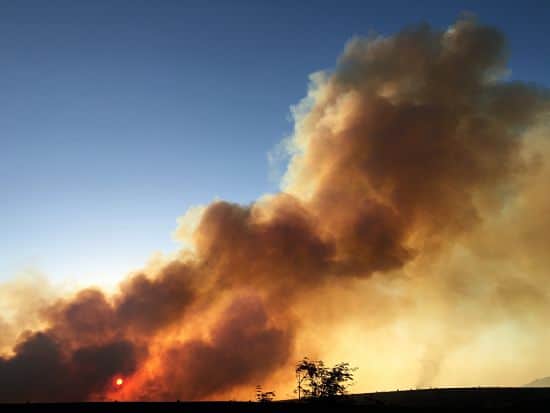
They burned with abandon. Before the fire had jumped the line, our back-burn was slow, methodical. Now it was all guns blazing. Still strategic and smart, but with considerably more swearing. Drip torches met dry earth, the winds whipped up, and the flames were carried back towards the main fire. The smoke plume quadrupled in size, as trees and brush and grass and animals unable to run went up in flames. This time the wind favored Man. You could hear the demon shrieking its goodbye. The intentional burn that the crew laid down met the runaway one, and the fire ceased. 10 hours later, within hundreds of yards of the backyards of the community that relied on these crews, it was done.
So, the Ransom Fire. That was what happened in a nutshell. Now here is what I experienced with things other than words.
Sight:
- The wall of flame. It was moving north, towards us. We were burning back towards it. I kept thinking “shouldn’t we get out of its way?” I kept looking at the guys’ reactions to judge if I should panic. No one looked concerned. It was dark orange, unlike the flame we were putting down which was light orange. The flame wall was dark because trees were torching in its march forward, creating black smoke.
-
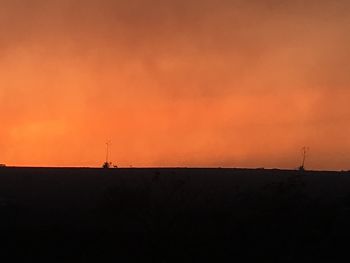
In the middle of the fire, you can see tiny silhouettes of deer fleeing. A family of four deer darted past us. Three adults, one young stag. Their fur was slightly smoking, but they didn’t look burnt. Maybe singed. Rabbits ran past us. A skunk was hauling ass. Faster than I ever knew a skunk could move. We all wished them luck.
- The air show. One command plane (who was looking down, telling us what the big fire was doing), two smaller helicopters dragging orange buckets of water, another plane dumping slurry (the red gashes that land on the ground, fire retardant), and then the big mama, the Chinook copter, carrying 2,100 gallons of water. They were hovering over us constantly, zooming in and out. Now you see them, now you don’t.
- Smoke. Everything looks epic. A person walking towards you is normal, a person walking towards you with a giant blaze and an acre of black smoke behind them looks like an action movie poster. I lose my sight every 20 or so seconds, and I blink furiously to bring things back to focus. Everyone is trading tips on how to make it sting less. I just have to wait for my eyes to go numb.
- The shimmer. You know when it gets really hot outside, and you see the heat mirages rising off the pavement? That’s what wildfire looks like, everywhere. Everything is a heat mirage, if you stare at one thing too long you start to feel queasy. It’s like you’re moving through a funhouse-mirrored room, made out of flames.
Sound:
-

The Chinook helicopter dropping water on the edge of the fire to prevent its spread. A fire sounds like ten thousand things at once. The sound is the most overwhelming part. Every time a tree torches (meaning it goes up like a match being struck), it sounds like 10 million pieces of Velcro being ripped at the same exact time. And then you add 2 trees, 3, 4…It gets loud. There are hums of the engine supplying you water to put out flames, the crackling of grass burning, the air show. My ears ache after a while.
- Bullets and bombs. Yes, actually. Some of the prisoners and correctional officers are U.S. military veterans, and they were yelling at me above the roar of the flames and the engines and the Chinook above that this wasn’t too far from a war zone. They would know. The fire was racing across 10 different military ranges, all of which had various explosive devices on the ground from previous training sessions. Bullets were popping every few minutes, and training bombs would explode (their blasts much less dangerous than actual bombs, but the sound was similar) every so often. Most of the time our backs were turned away from the fire, because we were looking for spot fires on the unburned grass ahead of us, so we would just hear bullets and bombs go off without seeing them. It was hard not to duck.
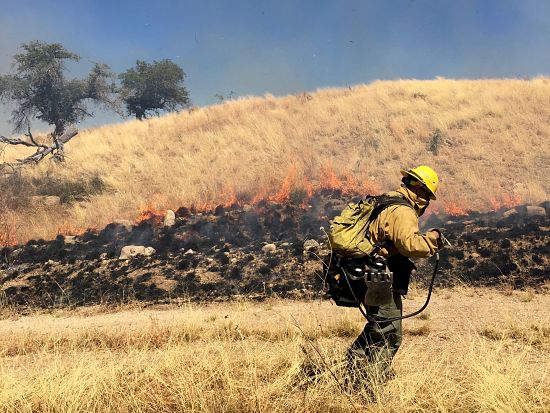
Smell:
- Wildfire smells good. It smells wrong, it triggers something deep within your lizard brain that says This Isn’t Right, but it also smells like raw power. Like a campfire, but mixed with gasoline and sweat.
- Slurry rains down from airplanes and it smells acrid and bitter. Everyone prays it doesn’t land on them, because it’s not good for your skin. Some guys love the smell of it, it means things got REAL. Most people say the smell makes them choke.
- The guys with drip torches get singed. Their hair burns, they have little patches missing where their clothes didn’t cover them. They smell their own burned hair the rest of the day.
Taste:
-
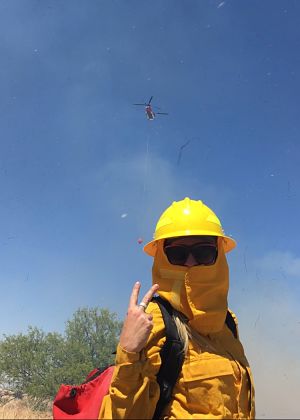
The anthropologist on the fire. At a certain point, my mouth is covered in ash. I swallow it. The shroud is wrapped around my mouth, the piece of fabric that attaches to my helmet and protects my neck and mouth and nose, which is a lifesaver but also didn’t let me blow my nose. So my nose starts running like I’m on a crazy ayahuasca trip, and I start inhaling the salt from my sweat and the snot from my nose and the ash from the fire and the only reason it doesn’t make me sick is because I’m not even paying attention to it.
- My water—my sweet, sweet water slung to my hips—has started to boil. It’s worse when it’s hotter outside, but the intense heat from the fire nullifies any fancy water storage unit I bought with a research grant. I drink my boiling water, because I have to. It tastes faintly like smoke.
Touch:
- My whole body is aching but I have no idea yet. I’ll feel it later. My skin has a flash burn, it looks like I fell asleep in the sun. Everyone is operating at probably 100 degrees, our blood feeling hot and slightly sludgy. I keep drinking water. My feet are starting to ache but I don’t let myself think about that yet. I still have so many more miles to go. When we’re done for the day, we will all take off our boots and compare blisters and burns. It’s a game no one wants to win.
- The Chinook misdirected his water bucket and we got slammed with 2,100 gallons of water. It was disgusting water, from some holding pond full of shit I don’t even want to think of, but oh god, it felt so good. We all high-fived.
- Reassurances. The guys are constantly physically checking in with each other. These crews do not pride themselves on machismo. They value the opposite: caring for one another and making sure they all stay safe and healthy. To do this on a fire, they have to get up close and personal. They adjust each other’s packs. They grab each other’s shoulders and squeeze, intimate reassurances. They high five or chest bump when they do something cool. They make each other look them in the eyes, to see that they are focused and hydrated. They make each other drink water. They check in like this with me too.
Body:
- My stomach flipped when I saw the wall of flames move towards us for the first time. One of the guys asked, “Are you OK?” And I said I was scared, a little. He said it was OK to be scared. I definitely felt a wave of nausea like I was going to puke, but I didn’t. He stuck by me the whole time after that, and asked how I was doing every 10 minutes.
- I am so tired. I can’t sleep tonight. I am in a fire department sleeping next to 23 dudes and they are all passed out and snoring. They are full, they ate at Golden Corral which is the most amazing thing to watch. I think they pretty much demolished the restaurant’s food supply. But I can’t sleep. I’m too amped. I need to sleep. But I keep seeing fire when I close my eyes.
-
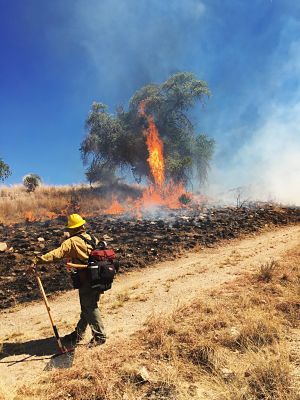
The fire demon. The demon. I had heard about this phenomenon, but this time I saw it. In each wildfire, a demon resides. You can never see it while you’re fighting it. Only when you look back at your pictures do you see a demonic shape in a singular flame. A head, like Edvard Munch’s The Scream, reaching out towards the camera. It appeared this time in a torching tree as a crewmember stood nearby. Apparently the demon is there to let you know it can kill you if you don’t keep your eyes and ears sharp, if you don’t watch out for falling trees or if you make a dumb decision. It is always lurking. On fires where firefighters have died, there is always a demon to be found when looking back at pictures. We were flipping through my pictures after dinner, all nestled in our sleeping bags, and I saw it. Someone else noticed it too. He shouted, “She got the demon!” I did, I had captured it. They all looked at the picture, it got quiet. Now I know that this is real.
Conclusion
I write this conclusion nearly nine months after I first scribbled these notes down. Looking back, I see that splitting my fieldwork experiences up into senses served not only as a good memory tool, but now serves as a useful analytical one. For instance, at the time I wrote this, I immediately decided that seeing a fire demon should be filed under the category ‘body’ as opposed to sight. Upon reflection, this may be because the fire demon is part of firefighting lore, and mythology runs deeper than discourse, seeping into the body and ways of being in the world. Fire demons are both talismans and omens; they tell you that you were safe, but only this time. They mean you survived, but with eyes on your back. With this point of analysis, I can now look at my other notes on the topic, and in places where it came up in formal interviews, and try to draw parallels between this and other symbolic demons. Working with men in prison, talk of demons—past, present, and future—certainly arises. Analyzing this connection may be productive for my work.
Prior to the Ransom Fire, I had never seen a massive ecological event like this up close. Every fire is different, and this one was not even near the most intense fire these crewmembers have fought. This was manageable. At all times, the experienced guys knew exactly what was happening. They could see it coming, could see where the fire would go, and knew what to do. Yet for the uninitiated, that day felt like I was watching a movie where everyone else had been privy to a pre-screening. Throughout the hours and miles, I relied on the prison crewmembers to repeat the dialogue they had already heard. I relied on them, truly, to survive. I channeled their bodies and their attitude, their wisdom and their strength. In this way, I think I decided to write fieldnotes that were multi-sensed—that were sensuous—in order to try and capture this intimate connection between fieldworker and informant. What I saw and heard and felt the day of the Ransom Fire, and every day throughout my 15 months on the line, was both my own and not my own. I was fighting wildfires, but not alone.
Fieldwork remolds you. You become plastic, your senses and memories and lives become enmeshed with others. On the fireline, when fieldwork becomes a battle, this is especially true.
[1] ‘On the line’ is a wildfire-fighting phrase that means the timeframe when crews are actively fighting fires, rather than being staged in a nearby camp or holding area. Wildland firefighters work shifts up to 16 hours at a time ‘on the line’ and then have to rest for several hours before being sent back.
[2] All fires have names. Some of the most epic ones go down in the annals of firefighting history, and a person need only reference the first name (like this one, Ransom) to spark a multi-hour recollection between crewmembers of the danger, the strategies, the failures and successes. For this essay and for all of my data, fire names have been changed to protect anonymity.
[3] Once Incident Command determines the general direction of the main fire, and if the conditions are favorable, crews will be sent to create a ‘box’ around it. This means they hike several miles in front of where the fire is headed, and using drip torches, burn a box shape back towards the head of the flames. Eventually the fire will reached the burned area, run out of fuel, and slowly extinguish itself.
[4] The most common job a wildland firefighter does is dig lines. Over the length of any fire’s edge, between the burned and not-burned area, crews dig a shallow, wide line into the ground (removing fuels, exposing bare soil), so the fire will have a less likely chance to cross to the green vegetation.
[5] A fire, like a human being, has an anatomical chart, replete with a head, heels, flanks, and fingers, to name a few. In this case, the flanks are the sides of the fire, which have to be contained so the fire doesn’t get wider and pick up more fuel and heat.
All photos courtesy of Lindsey Feldman

